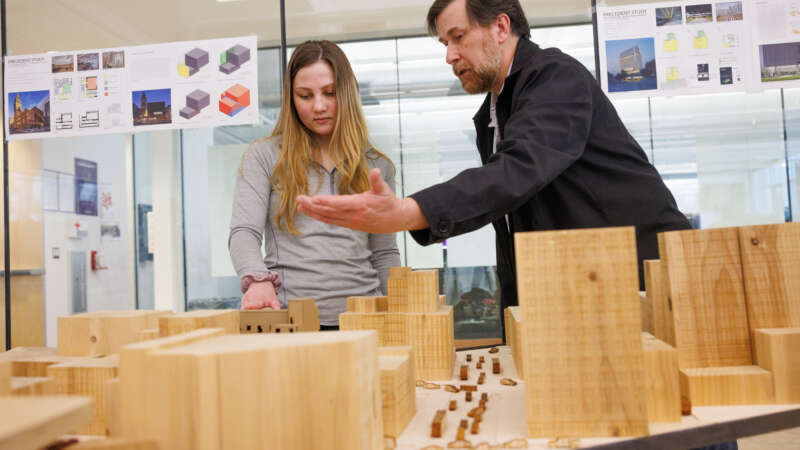Students work with high school freshmen to design a new successful learning environment
Overview of the project
Starting in the fall 2017 semester, two faculty members in the interior architecture and product design program engaged with fifth year K-State architecture students to work with JC Harmon High School in Kansas City, Kansas. They explored the idea of renovating the high school to improve the learning environment and initiated conversations with the Harmon High youth. This 2018 spring semester, an interdisciplinary group of K-State architecture and landscape architecture students and faculty worked hands-on with JC Harmon freshmen to expose them to architecture professions. They worked with the students to gather information about wants and needs for JC Harmon and to design a successful and functional learning environment.
Madison Quincke, third year landscape architecture student at K-State from Osawatomie, Kansas gives her insight on the project. “The project integrated both third-year landscape architects with third-year architects at Kansas State University. Our studio was sponsored by a firm in Overland Park, Kansas called DLR Group. Our role in the project was to engage with the current Architecture, Construction, and Engineering (ACE) Academy freshman students and teachers gathering information about needs as well as wants for JC Harmon. We had three meetings with the students, one of which was here at K-State. During those meetings we did short design meetings and activities to get to know the students as well as their thoughts about JC Harmon.”
Quincke shared the process of working with the high school students. “First, we focused on gathering information about JC Harmon, the community and completed a series of presentations sharing with the class our findings. Next, our task was to design a learning environment that had strong indoor/ outdoor relationships. The second half of the semester, the landscape architecture students developed the site while the architecture students developed the school building. It was a lot of a “back and forth” process that went on between the landscape architecture and architecture students to achieve a well-integrated school and site design in the end. We had multiple critiqued reviews with DLR Group throughout the semester to get their feedback; they even attended our final gallery-style review at the end of our semester.”
Quincke hopes that the engagement with college students encourages the freshmen to think about their future and the different jobs that can come with an architecture degree. Like many urban schools, JC Harmon is striving to improve its graduation rate and foster college and career readiness. She hopes this project sparked interest in the students to continue their education.
Overall, Quincke is very happy with having the experience of working in a real-world situation. She knows that this project experience will enable her to be more successful in her future career. “This project was also very socially complex as the Argentine community, where JC Harmon is located, is an underserved, primarily minority community that needs help with redevelopment and connection to surrounding communities,” Quincke said. “As cities become a more popular place to live, the redevelopment of socially complex urban communities will be a challenge landscape architects will need to overcome.”
Planning the project
Katie Kingery-Page, an associate professor in the department of landscape architecture and regional and community planning (LARCP) at K-State, worked closely with her colleagues, Assistant Professor Hyung Jin Kim (LARCP) and Associate Professor Michael Gibson in the department of architecture to guide the interdisciplinary students involved in this project. She described the goals of the project as: learn about neighborhood scale and analysis design, learn about site planning and design for an educational facility, learn about building programming and design for a 21st century learning environment and engage with real-life stakeholders to understand their needs and hopes for a school environment. Kingery-Page shares the first steps of beginning this project, “The interdisciplinary K-State design teams of architecture and landscape architecture students began by exploring the social, demographic, cultural, historical and environmental contexts and challenges existing in the Argentine neighborhood beyond the physical boundaries of the high school site.”
Wyandotte County residents have worked around many challenges, such as high poverty and unemployment rates. Believing the improvement of the new school will be one of the most potent catalysts for solving neighborhood problems, students discussed and thought of different ways to integrate school improvement by finding the neighborhood strengths, weaknesses, opportunities, and threats. This analysis helped established the revitalization plan in relation to the area of influence of the new JC Harmon High School.
After analyzing the site and neighborhood, the students combined into smaller teams and started to learn about theories of learning, behavior and the environment. They were then asked to design a vision for a place of learning: an indoor-outdoor learning environment for one hundred students and faculty. “The final outcomes of the combined studios included a series of comprehensive master plans for a new Harmon school facility and outdoor learning site. Throughout the process, K-State student learning was informed by the Harmon stakeholders and professional critics from DLR Group,” Kingery-Page says. “We hope the demographically diverse students of Harmon will envision themselves as future architects or landscape architects. In addition, we hope the Harmon ACE Academy freshmen learned that all kinds of leadership skills and personality types are needed in design professions. We hope that each individual may begin to imagine themselves in our K-State students’ shoes: making progress toward a professional career goal.”
Funding of the project
A multi-disciplinary design firm, DLR Group was a big part of this project in terms of funding and working with the students and high school while this project was on going. Scott Pashia, senior project manager, DLR Group stated why they decided to fund this project. “DLR is a national leader in K-12 design and has a focus on research and development in that area, so this seemed like a great opportunity to collaborate with the K-State students as they developed their projects.”
Stemming from a previous engagement DLR already had with the College of Architecture, Planning and Design to support a studio, a conversation had formed about developing a studio sponsorship. Dean of the college, Tim de Noble, initiated conversations to have a partnership for this project between JC Harmon High School, DLR and K-State. The DLR group hopes this project has a positive impact. By engaging students, teachers and the community they will all start to have a greater understanding of how education is changing.
High school perspective
David Bennett, science teacher for ACE academy (architecture, construction and engineering) at JC Harmon High School, shares the benefits from this project. “Working with the professors and students from K-State introduced our high school freshmen to professional collaboration,” Bennett said. “They were able to see the architecture and landscape architecture projects take shape over time. It was even more enriching because these projects were grounded in the experience and environment in which our freshmen live.
The impact that this project had on the students helped them to see how they can expand the limits on what is possible within their community. With the freshmen students seeing the approaches of the K-State students as they thought of ideas to design a new environment, it helped show how their ideas can be set in motion as well. Bennett shares about the project in terms of the future. “The ways that the ecology of our site was integrated into the K-State student projects is a particularly potent shift,” he said. “Our students at both schools are recognizing that designing with nature in mind is an essential part of the process.”
The project between K-State landscape architecture and architecture students and JC Harmon High School students with the funding from DLR has opened both the college students, as well as the freshmen, to different experiences. The college students interacted with others outside of the class room for real-world experience, the freshmen were exposed to a college experience and hopefully inspired to continue on their education. “Our brightest moment came at the end of the campus tour, when several Harmon High teachers told us their students could ’see themselves at K-State.’ Creativity demands diversity — we hope the Harmon youth see themselves as future problem solvers and creative thinkers in a world that needs them,” Kingery-Page said.





